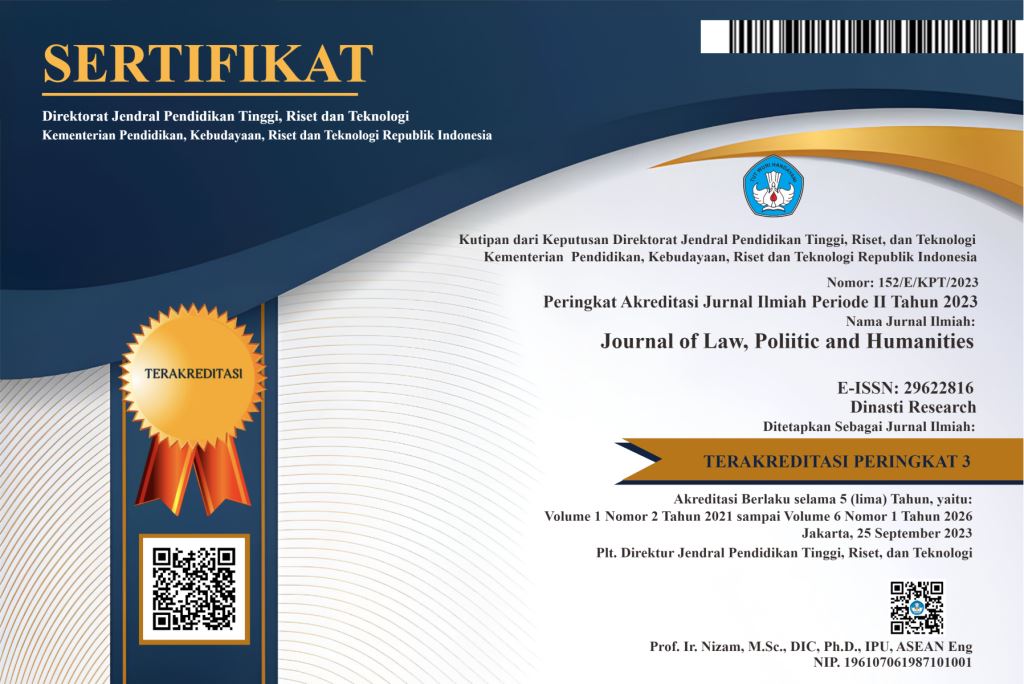Analysis Of The Role Of Regional Governments And The Ministry Of Law And Human Rights In The Formation And Harmonization Of Draft Regional Regulations After UU Nomor 15 Tahun 2019
DOI:
https://doi.org/10.38035/jlph.v5i6.2323Keywords:
Regional Office of the Ministry of Law and Human Rights, Harmonization, Legislation Forming InstitutionsAbstract
Law Number 12 of 2011 concerning the Establishment of Legislations, was established with the hope that it can serve as a guide in the formation of laws and regulations which are implemented in a definite, standard, and standard manner and method that binds all institutions authorized to form laws and regulations. . However, during its implementation there were several problems in its implementation. Based on this, Law No. 15 of 2019 concerning Amendments to Law No. 12 of 2011 was promulgated on the Establishment of Legislation. One of the changes in Law No. 15 of 2019 is the authority to harmonize, unify, and consolidate the conception of the Draft Regional Regulation which was originally the authority of the Regional Government to become the authority of the Ministry of Law and Human Rights as long as the Ministry or Institution that carries out affairs in the field of Formation of Legislative Regulations Invitation has not yet been formed. The impact of the change in authority is the occurrence of a wave of requests for harmonization to the Regional Office of the Ministry of Law and Human Rights in Central Java. This thesis research aims to determine the role of the Regional Office of the Ministry of Law and Human Rights of Central Java in the process of harmonizing, concluding, and strengthening the conception of the Draft Regional Regulation, legal consequences, obstacles faced, and solutions. The type of this thesis research is descriptive qualitative and sociological juridical approach method. By using the theory of the rule of law, the theory of statutory science, and the theory of the formation of laws and regulations from the perspective of Islamic law as the basis for the study, it was concluded that the role of the Regional Office of the Ministry of Law and Human Rights of Central Java was as an extension of the Ministry of Law and Human Rights of the Republic of Indonesia in harmonizing the Draft Law. Regional Regulations in accordance with the provisions of laws and regulations both vertically and horizontally, Pancasila, the 1945 Constitution of the Republic of Indonesia and ensure that the formation of Provincial/Regency/City Regional Regulations is in accordance with the provisions of the establishment of laws and regulations. The obstacle faced is the lack of coordination which causes it to seem to extend the mechanism for the formation of laws and regulations in the regions.
References
Arikunto. 2006. Prosedur Penelitian Suatu Pendekatan Praktek. Jakarta: PT. Rineka Cipta.
Bambang Waluyo, 1991, Penelitian Hukum dalam Praktek, Sinar Grafika, Jakarta. Bahder Johan Nasution, 2008, Metode Penelitian Ilmu Hukum, Mandar Maju,
Bandung.
Bivitri Susanti,Menyoal Jenis dan Hierarki Peraturan Perundang-undangan di Indonesia, Jurnal Jentera, Volume 1 No. 2, 2017.
Busroh, Firman Freaddy, Konseptualisasi Omnibus Law dalam Menyelesaikan Permasalahan Regulasi Pertanahan, Jurnal Arena Hukum. Volume 10 No.2, Agustus 2017.
Departemen Pendidikan Nasional,2005, Kamus Besar Bahasa Indonesia,Balai Pustaka, Jakarta
Didik Sukriono, 2013, Hukum, Konstitusi, dan Konsep Otonom, Setara Press, Malang.
Fery Irawan Febriansyah, Konsep Pembentukan Peraturan Perundang-undangan di Indonesia, Jurnal Perspektif, Vol. XXI, No. 3, 2016.
I Wayan Parsa, Hubungan Pusat dan Daerah (Suatu Pendekatan Teoritis), FH Universitas Udayana, Denpasar, 2015.
Indah Sari,Federal Versus Kesatuan: Sebuah Proses Pencarian Terhadap Bentuk Negara Dalam Mewujudkan Otonomi Daerah, Jurnal Ilmiah Hukum Dirgantara, FH Universitas Suryadarma ,Volume 5 No.2, Maret 2015.
J. Supranto, 2003, Metode Penelitian Hukum dan Statistik, Rineka Cipta, Jakarta.
Jimly Asshiddiqie, 2005, Konstitusi & Konstitusionalisme Indonesia, Edisi Revisi, Konstitusi Press, Jakarta.
Juli 2021.
Lukman Santoso, 2016, Negara Hukum dan Demokrasi: Pasang Surut Negara Hukum Indonesia Pasca Reformasi, IAIN Press, Ponorogo.
Maria Farida Indrati Soeprapto, 2007, Ilmu Perundang-undangan, Kanisius, Yogyakarta.
Moh. Kusnardi, 1987, Hukum Tata Negara Indonesia , Sinar Bakti, Jakarta,
Moh. Mahfud MD, 1999, Hukum dan Pilar?pilar Demokrasi, Gema Media, Yogyakarta.
Muhtarom, Review Artikel: Kedudukan Peraturan Perundang-undangan Negara dalam Institusi Hukum Islam Karya Drs. H. Abd. Salam, Suhuf, Vo.27, No. 1, Mei,2015.
Peraturan Menteri Hukum dan HAM Nomor 25 Tahun 2015 tentang Tata Cara Dan Prosedur Pengharmonisasian, Pembulatan, Dan Pemantapan Konsepsi Rancangan Peraturan Perundang-Undangan.
Peraturan Pemerintah Nomor 59 Tahun 2015 tentang Keikutsertaan Perancang Peraturan Perundang-Undangan Dalam Pembentukan Peraturan Perundang- Undangan Dan Pembinaannya.
Peraturan Presiden Nomor 44 Tahun 2015 tentang Kementerian Hukum dan Hak Asasi Manusia.
Peraturan Presiden Nomor 87 Tahun 2014 tentang Peraturan Pelaksanaan Undang- Undang Nomor 12 Tahun 2011 tentang Pembentukan Peraturan Perundang- undangan.
Pusat Studi Hukum dan Kebijakan Indonesia, Menggagas Arah Kebijakan Reformasi Regulasi di Indonesia: Prosiding Forum Akademik Kebijakan Reformasi Regulasi 2019, Jakarta, Oktober 2019.
Rika Marlina, Pembagian Kekuasaan Dalam Penyelenggaraan Pemerintahan Di Indonesia, Jurnal Daulat Hukum, FH Universitas Sultan Agung, Vol.1 No. 1 Maret 2018.
Saiful Bahri, Dasar-Dasar Penyusunan Peraturan Perundang-undangan. http://www.legalitas.org/database/artikel/htn/dasar2.pdf, diakses 27
Undang-Undang Dasar Negara Republik Indonesia Tahun 1945.
Undang-Undang Nomor 12 Tahun 2011 tentang Pembentukan Peraturan Perundang-undangan.
Undang-Undang Nomor 15 Tahun 2019 tentang Perubahan Atas Undang-undang Nomor 12 Tahun 2011 tentang Pembentukan Peraturan Perundang-undangan.
Undang-Undang Nomor 23 Tahun 2014 tentang Pemerintahan Daerah sebagaimana diubah terakhir kali dengan Undang-undang Nomor 11 Tahun 2020 tentang Cipta Kerja.
William Robinson, “How the European Commission drafts legislation in 20 languages”. Clarity (Journal of the international association promoting plain legal language), No.53, May 2005.
Downloads
Published
How to Cite
Issue
Section
License
Copyright (c) 2025 Thoyyib Mu'ammar, Amalia Diamantina

This work is licensed under a Creative Commons Attribution 4.0 International License.
Authors who publish their manuscripts in this journal agree to the following conditions:
- The copyright on each article belongs to the author(s).
- The author acknowledges that the Journal of Law, Poliitic and Humanities (JLPH) has the right to be the first to publish with a Creative Commons Attribution 4.0 International license (Attribution 4.0 International (CC BY 4.0).
- Authors can submit articles separately, arrange for the non-exclusive distribution of manuscripts that have been published in this journal into other versions (e.g., sent to the author's institutional repository, publication into books, etc.), by acknowledging that the manuscript has been published for the first time in the Journal of Law, Poliitic and Humanities (JLPH).


























